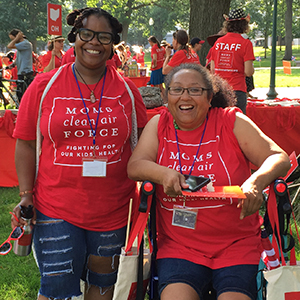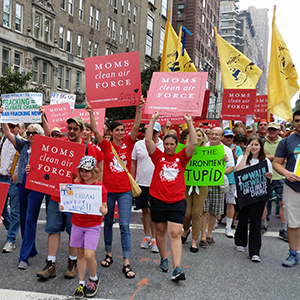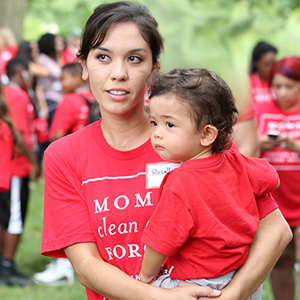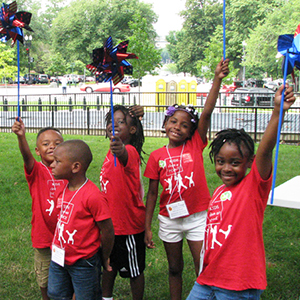
This was written by Karen Valentine for Climate Progress:
Pavel Snejnevski showed up to the parking lot in Northeast D.C. in a gray suit and tie. He’d be returning to work later that afternoon, but now he had a more pressing task, one for which he was willing to brave the unseasonably cold May rain in his work clothes: to pick up the box of bees he’d ordered earlier this year so he could install them at his friend’s house in Woodley Park.
Snejnevski, a psychotherapist who lives in Georgetown, was one of steady stream of city beekeepers of a range of ages and experience levels who showed up that Wednesday to pick up their bees. The beekeepers, most of whom live within the city’s limits, join a group of urban and suburban beekeepers whose numbers have been growing rapidly over the last few years as local food movements gain traction and the plight of bees attracts more attention and concern.
“There’s a tremendous interest in beekeeping now,” said Wayne Esaiais, a beekeeper and lead scientist at NASA’s HoneyBee Net. “People are worried about bees and what their difficulties imply for the rest of the ecology.”
From 2008 to 2013, the number of urban beekeepers has tripled in London, and New York City, which legalized urban beekeeping in 2010, has also seen a jump in beekeepers. The rise in urban and suburban beekeepers could be good news for bee populations, which have taken a turn for the worst over the last few years.
Though a recent federal report found fewer honeybees died last winter than the winter before, bee populations are still struggling. As one entomologist told the New York Times, the newly-released bee numbers show bee losses have gone “from horrible to bad” and that there was no way to tell why the bee population had a slight rebound last winter — or whether the upward trend will continue. And in some states, bee populations have shown no improvement, and have even dipped lower than the national average. In Ohio, for instance, county bee inspectors reported losses of 50 to 60 percent over the winter.
Dramatic declines in bee populations is bad news for the country’s crops. According to the USDA, one-third of all food and beverages consumed in the U.S. are dependent on pollination of some sort, with key crops such as almonds and squash depending most heavily on bees.
That’s where the rise in home beekeeping plays an important role. It won’t solve the bee die-offs problem — huge numbers of commercialized bees are needed to pollinate some of the nation’s most important crops, and backyard beekeeping won’t help much with that — but it helps overall bee numbers. And there’s an added benefit: beekeeping is doing a lot to teach city and suburban dwellers about bees, the importance of green space and pollinator-attracting plants, and how climate change’s effects on seasons is adding to the threats the insects face.
“What we have is most of our population living in cities,” said Hartmut Doebel, assistant professor at George Washington University and head of the school’s beekeeping and bee research program. “So if we can promote beekeeping in the cities and create a little bit more awareness about what these critters need and what harms them, I think we are really making the best use of this bee model to educate large numbers of people.”
Bees and Climate Change
Many new beekeepers were turned on to the practice after learning of the dangers bees were facing from pesticides and disease. But Toni Burnham, who’s been keeping bees in D.C. since 2005 and leads the D.C. Beekeepers Alliance, says becoming a beekeeper forces you to tap in to climatic changes as well.
In 2005, she said, her bees would arrive on April 9, a date that gave beekeepers enough time to install their hives and get their bees settled in before key trees — the tulip poplar and black locust — began to bloom. Now, in 2014, her bees were delivered May 7, a full month later. The black locusts were already blooming — bad news for the bees, which need time to settle into their new hives and would likely miss the peak foraging period for the black locusts.
“It’s incredibly difficult to know anything anymore,” Burnham said.
At NASA’s HoneyBee Net, Esaias is working with beekeepers across the U.S. to track changes in nectar flow as the climate warms. So far, data from Maryland suggest that peak nectar flow — the period of time where trees are in peak bloom, providing the most nectar for foraging bees — occurs almost four weeks earlier than it did in 1970. That early bloom impacts the health of hives, Esaias said, because on the East Coast, bees depend on a few weeks of tree bloom to get the bulk of their nectar for the year. If bees miss the peak foraging time, the overall health of the hive is weakened.

“When the winters get warmer, and the trees bloom earlier, our colonies are weaker going into the nectar flow, and therefore they can’t collect enough,” he said.
These climatic changes add to the stress that bees are already under, due to mite and disease outbreaks and pesticide exposure.
“Much like people in high stress situations, their health suffers, they’re not as in good shape, and then they can get disease and die,” Esaias explained.
Mischa Hall, a data mining analyst who started keeping bees in D.C. last year, said the unpredictability of the seasons — even in the one year she’s been keeping bees — have made keeping her hive alive difficult.
“This year our winter was so harsh and the spring started later than normal, so everything was in bloom at once, as opposed to having things go in succession,” she said. “Everything started blooming immediately. It was like everyone had nothing to eat and then it went on steroids.”
Hall said that last year, her hive didn’t survive the winter. This year she’s trying again with two hives, and hopes the winter is milder. And the challenges don’t end with winter. Soochon Radee, a software engineer who’s been keeping bees in D.C. for three years, said the weather has been different every year since he started beekeeping.
“The summers just keep changing, and they aren’t getting any better,” he said. “I really worry about whether or not there’s enough rain to keep my plants and flowers healthy enough for bees to come.”
Eve Bratman, assistant professor at American University and faculty adviser for American’s Beekeeping Society, said a changing climate could force the U.S. to turn to other breeds of honeybees — rather than the ever-popular Italian breed, which is most commonly used in U.S. hives, both commercial and personal — in order to keep crops pollinated.
“In the age of climate change, we are increasingly needing stronger breeds of bees,” she said, adding that she thinks investing in these stronger bees could be as important as keeping bees locally. And as seasons change around the country, Bratman said beekeepers will need to look to other regions to see how they raise their bees — a beekeeper in D.C., for instance, could learn a lot from beekeepers in Canada and the Midwest about how to keep bees alive during a harsh winter.
In the city, though, humans’ careful attention to their lawns and gardens may protect honeybees from some of the impacts of climate change. Drought, for instance, likely won’t hit bees as hard in the city, because water restrictions don’t usually kick in until the most severe levels of drought.
CONTINUE READING this post about the challenges of urban beekeepers at CLIMATE PROGRESS




